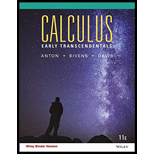1 Limits And Continuity 2 The Derivative 3 Topics In Differentiation 4 The Derivative In Graphing And Applications 5 Integration 6 Applications Of The Definite Integral In Geometry, Science, And Engineering 7 Principles Of Integral Evaluation 8 Mathematical Modeling With Differential Equations 9 Infinite Series 10 Parametric And Polar Curves; Conic Sections 11 Three-dimensional Space; Vectors 12 Vector-valued Functions 13 Partial Derivatives 14 Multiple Integrals 15 Topics In Vector Calculus expand_more
15.1 Vector Fields 15.2 Line Integrals 15.3 Independence Of Path; Conservative Vector Fields 15.4 Green’s Theorem 15.5 Surface Integrals 15.6 Applications Of Surface Integrals; Flux 15.7 The Divergence Theorem 15.8 Stokes’ Theorem Chapter Questions expand_more
Problem 1QCE: Let be a piecewise smooth oriented surface that is bounded by simple, closed, piecewise smooth... Problem 2QCE: We showed in Example 2 that the vector field F(x,y,z)=2zi+3xj+5yk satisfies the equation curl... Problem 3QCE: (a) If 1and2 are two oriented surface that have the same positively oriented boundary curve C, and... Problem 4QCE: For steady-state flow, the maximum circulation density occurs in the direction of the of the... Problem 1ES: Verify Formula (2) in stokes’ Theorem by evaluating the line integral and the surface integral.... Problem 2ES: Verify Formula (2) in stokes’ Theorem by evaluating the line integral and the surface integral.... Problem 3ES: Verify Formula (2) in stokes’ Theorem by evaluating the line integral and the surface integral.... Problem 4ES: Verify Formula (2) in stokes’ Theorem by evaluating the line integral and the surface integral.... Problem 5ES: Use Stokes’s Theorem to evaluate CF.dr. F(x,y,z)=z2i+2xjy3k;C is the circle x2+y2=1 in the... Problem 6ES: Use Stokes’s Theorem to evaluate CF.dr. F(x,y,z)=xzi+3x2y2jyxk;C is the rectangle in the plane z=y... Problem 7ES: Use Stokes’s Theorem to evaluate CF.dr. F(x,y,z)=3zi+4xj+2yk;C is the boundary of the paraboloid... Problem 8ES: Use Stokes’s Theorem to evaluate CF.dr. F(x,y,z)=3y2i+4zj+6xk;C is the triangle in the plane z=12y... Problem 9ES: Use Stokes’s Theorem to evaluate CF.dr. F(x,y,z)=xyi+x2j+z2k;C is the intersection of the... Problem 10ES: Use Stokes’s Theorem to evaluate CF.dr. F(x,y,z)=xyi+yzj+zxk;C is the triangle in the plane... Problem 11ES: Use Stokes’s Theorem to evaluate CF.dr. F(x,y,z)=(xy)i+(yz)j(zx)k;C is the circle in the plane... Problem 12ES: Use Stokes’s Theorem to evaluate CF.dr. F(x,y,z)=(z+sinx)i+(x+y2)j+(y+ez)k;C is the intersection... Problem 13ES: Determine whether the statement is true or false. Explain your answer. Stokes’ Theorem equates a... Problem 14ES: Determine whether the statement is true or false. Explain your answer. Stokes’ Theorem is a... Problem 15ES: Determine whether the statement is true or false. Explain your answer. The circulation of a vector... Problem 16ES: Determine whether the statement is true or false. Explain your answer. If F(x,y,z) is defined... Problem 17ES: Consider the vector field given by the formula F(x,y,z)=(xz)i+(yx)j+(zxy)k (a) Use stokes’ Theorem... Problem 18ES: (a) Let denote the surface of a solid G with n the outward unit normal vector field to . Assume... Problem 19ES: The figures in these exercises show a horizontal layer of the vector field of a fluid in which the... Problem 20ES: The figures in these exercises show a horizontal layer of the vector field of a fluid in which the... Problem 21ES: Let F(x,y,z) be a conservation vector field in 3-spacce whose component function have continuous... Problem 22ES: In 1831 the physicist Michael Faraday discovered that an electric current can be produced by varying... Problem 23ES: Let be the portion of the paraboloid z=1x2y2 for which z0, and let C be the circle x2+y2=1 that... Problem 24ES: Discuss what it mean to say that the curl of a vector is independent of a coordinate system. Explain... Problem 25ES: Compare and contrast the Fundamental Theorem of Line Integrals, the Divergence Theorem, and... format_list_bulleted

